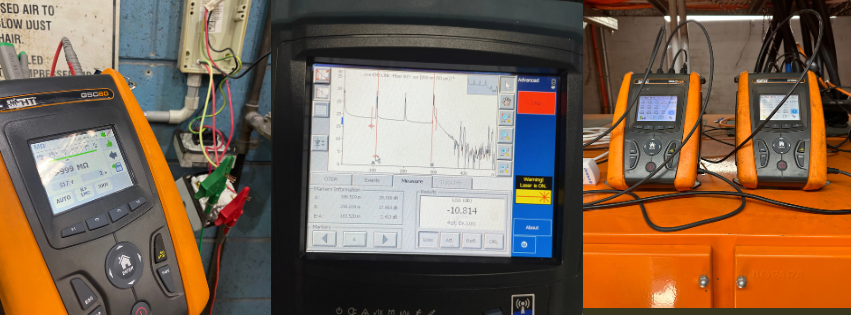OPTILINK offers general Low Voltage Testing for all residential, commercial, and industrial installations. Whether it be fault finding or just peace of mind OPTILINK can definitely put our clients minds at ease.
The Wiring Rules require that electrical contractors and electricians to perform tests on low voltage installations before they are connected to supply.
But do they REALLY matter?
Will it REALLY affect an installation?
Aren’t they a waste of time?
Many electrical contractors & electricians feel they are, and it’s not worth their time.
So are they important? YES!!
Why?? To ensure the correct and safe (ongoing) operation of an electrical installation. That is their purpose, and this is what it’s about:
- Test the continuity of the earthing system. Put simply this ensures that an ‘earth’ exists and it is suitable to ensure the fuse/circuit breaker will operate before a piece of ‘faulty’ equipment becomes ‘live’, potentially killing somebody.
- Insulation resistance. If this is too low, we risk equipment inadvertently becoming ‘live’, fires and overheating from ‘leakage currents’, and ‘equipment damage’ (particularly with electronics in equipment today.
- Polarity. To ensure ACTIVE (A), NEUTRAL (N) and EARTH (E) wires are in the right position. Does that matter? Yes! I.e. swap A and E and risk livening the frame of a piece of equipment and somebody can die. Or, put the earth wire in the wrong place and it will carry load current, melt and cause a fire. (Remember, the earth wire is often smaller than the A and N.)
- Correct Circuit connections. Ensures that circuits are not suitably connected in such a way that may cause safety hazards or incorrect operation. I.e. A piece of equipment being inadvertently connected to two (2) sources of supply is potentially life threatening to an electrician working on the circuit.
- Fault loop Impedance. (This is associated closely with voltage drop). The Wiring Rules mandate that under fault, a maximum voltage of 50 V can exist on a piece of equipment for no longer than 0.4 seconds before the circuit protection operates (see touch voltage). If the fault loop impedance is incorrect, this will not happen.
- Operation of R.C.D.s. Under the wiring rules, R.C.D.s are (currently) only required to be fitted to certain circuits where it has been deemed that safety is ‘more than normally’ likely to be a concern, i.e. kids sticking a fork in the toaster or socket outlet etc. For that reason it is crucial to ensure the R.C.D.s installed actually operate.
NOTE: Many of these tests operate together as a package. They are not intended to be freestanding on their own.
Although the above is the technical aspect of our trade in testing, it’s a very important aspect towards an installation, at OPTILINK we strive to educate this importance to clients to ensure that their installation is safe and in great hands.

